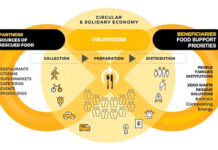In the case of nuclear radiation, it is essential to know how to reduce exposure to its harmful effects and protect yourself to the extent possible.
In the hope that reason and dialogue will prevail over conflict and the use of weapons, a brief review of recommendations and shielding materials.
There are also those who prepare and invest in bunkers while studying the prospects for survival and food security in a catastrophic scenario. The Big Chill.
1) Protecting yourself from radiation, the ABC’s.
Exposure to radiation is common throughout the life course, due to naturally occurring minerals as well as diagnostic radiological examinations (rX, CT). Under conditions of high exposures, such as in the case of nuclear explosions, EPA(Environment Protection Agency, USA) recommends radiation protection following the principle of ‘time, distance and shielding‘:
– time. Minimizing the exposure time is important, also considering the contribution due to natural radiation,
– distance. By increasing the distance from the radiation source, the radiation dose can be reduced,
– shielding. Introducing barriers (e.g., concrete, lead, water) between the individual and the radiation is helpful in protecting them from gamma rays and X-rays. (1)
Iodine intake, as noted above, is itself important.

2) Shielding
2.1) Conventional materials
Concrete is the most common shielding material for Gamma ray protection, alone or added with heavy metals to increase density and protective effectiveness against radiation. Lead-though effective and ductile-requires caution as it is toxic. Bismuth represents a better, non-toxic and equally effective alternative to it.
Boron-among the materials that can prevent the release of secondary gamma rays as well as absorb radiation-is far cheaper than other ‘neutron moderators’ (e.g., cadmium, lithium). In its carbide form, it has proven capable of absorbing radiation without forming radioactive isotopes, with a yield of up to 96 percent.
Other potentially useful materials include epoxy resins, kerosene wax, and various polymers, plastic and non-plastic (e.g., “I’m not a polymer”). polyethylene, polypropylene, polyvinyl chloride (PVC) and polycarbonate). (2)
2.2) Alternative and sustainable materials.
Several natural rocks-olivinic basalt, compact basalt, jet black granite, pink granite, limestone, sandstone and diabase-have been found to be better than concrete in protecting against Gamma rays and the like, also showing great promise as economical and sustainable. (3)
The experience of Fukushima (2011) allowed experimentation with the use of materials often found in the home to protect citizens from residual radiation. Paper (compact sheets, newspapers, magazines) and wood (boards, planks) at a minimum compact thickness of 20 mm proved effective in containing radiation. Up to 90% in the case of 50 mm thickness. (4)
3) Personal protective equipment
Personal protective equipment (PPE) has been developed for radiology and nuclear facility workers. Leaded goggles and aprons (preferably full-body, rather than front-on only), protective robes and portable ‘rolling shields,’ if properly employed, can theoretically contain radiation exposure by up to 90 percent.
Dosimeters make it possible to calculate the cumulative radiation level. They are worn outside and inside protective clothing to calculate by difference the level of radiation to which operators have been exposed. (5) Clothes (with two or more layers) are not suitable for containing radiation, although useful in reducing exposure to radioactive dust from nuclear fallout. (4)
4) Prepping
Prepping is the provision of conditions for adaptation to catastrophic environmental situations (e.g., epidemics, nuclear accidents). Bunkers where to survive for longer or shorter periods, isolated from the outside world. To the extreme of Survival Condo, a former missile silo repurposed as a 15-story bunker in the U.S. that can provide air, light and power — as well as water and food — for 75 people for five years. Even cinema, theater, bar, swimming pool, with US$ 20 million investment in an elitist dystopian perspective.
Sad curiosity, the prepping business is growing (US$ 500 million in sales in the U.S. alone) and is also developing in countries far from the United States of America where it originated. The perception of a permanent crisis is increasingly increasing the number of preppers. So are survival food sales, another market that several large players in the U.S. are focusing on, including in the distribution sector. (6)
5) The Big Chill
The Big Chill is the prospect of the coming winters without natural gas or fossil fuels from Russia. (7) Methane from Algeria will not be able to meet Italy’s needs before 2024, and unsustainable liquefied shale gas will be insufficient to supply Europe, as well as about 50 percent more expensive. Production costs of agricultural commodities will continue to rise, in line with those of energy and commodities (8.9).
The doomsday scenario, in the event of an extended nuclear conflict, is a global solar catastrophe with devastating effects on the world’s agricultural systems for more than 15 years. The most recent study on the subject (Winstead et al., 2022) points to wild edible plants(Wild Edible Plants) as food security ‘buffers’ as they are tolerant to shade, cold and post-drought drought. ‘We also propose policy initiatives for habitat protection, educational programs and general preparedness,’ the researchers say. (10)
#NoWar, #StopWar, #NotInOurNames.
Dario Dongo and Andrea Adelmo Della Penna
Notes
(1) EPA(United States Environmental Protection Agency). Protecting Yourself from Radiation. Last updated on 05/21/2021, https://www.epa.gov/radiation/protecting-yourself-radiation (accessed on 4/18/22)
(2) Miamiao et al. (2021). Research and application of nuclear radiation protection materials. IOP Conf. Series: Earth and Environmental Science 859:012093, https://doi.org/10.1088/1755-1315/859/1/012093
(3) Sultan Al-Buriahi et al. (2021). Nuclear Radiation Shielding Characteristics of Some Natural Rocks by Using EPICS 2017 Library. Materials 14:4669, https://doi.org/10.3390/ma14164669
(4) Daisuke Kobayashi et al. (2013). Reducing radiation exposure using a commonly available objects. Environ. Health Prev. Med. 18:261-266, https://doi.org/10.1007/s12199-012-0314-6
(5) Frane & Bitterman. Radiation Safety and Protection. NCBI Bookshelf. Last updated 5/29/21, https://www.ncbi.nlm.nih.gov/books/NBK557499/
(6) Bradley Garrett (2021). Doomsday preppers and the architecture of dread. Geoforum 127:401-411, https://doi.org/10.1016/j.geoforum.2020.03.014
(7) Dario Dongo. Gas and electricity, a crisis foretold. GIFT(Great Italian Food Trade). 20.3.22, https://www.greatitalianfoodtrade.it/mercati/gas-ed-energia-elettrica-una-crisi-annunciata
(8) Dario Dongo. Food security, thesis and antithesis of the European Parliament. GIFT(Great Italian Food Trade). 3/27/22, https://www.greatitalianfoodtrade.it/idee/food-security-tesi-e-antitesi-del-parlamento-europeo
(9) Dario Dongo and Maria Rosaria Raspanti. War economy. State aid in agribusiness, European fisheries fund, record high food prices. GIFT (Great Italian Food Trade). 8.4.22, https://www.greatitalianfoodtrade.it/mercati/war-economy-aiuti-di-stato-nel-settore-agroalimentare-fondo-europeo-per-la-pesca-record-dei-prezzi-alimentari
(10) Winstead, D.J., Jacobson, M.G. (2022). Food resilience in a dark catastrophe: A new way of looking at tropical wild edible plants. Ambio. https://doi.org/10.1007/s13280-022-01715-1









